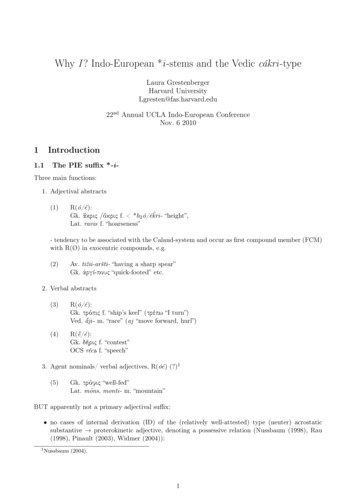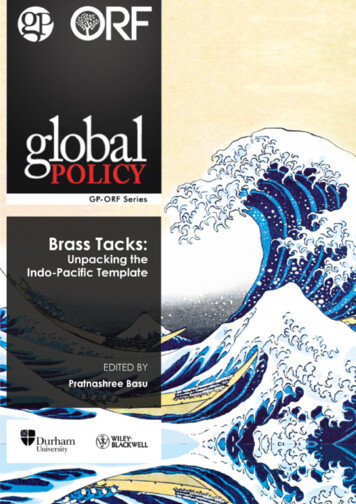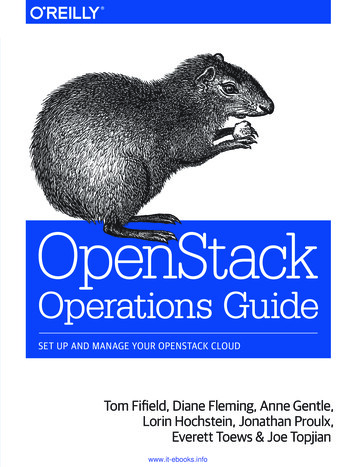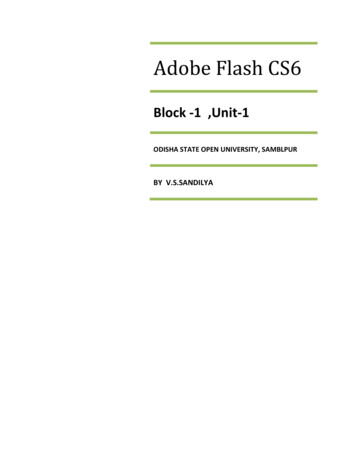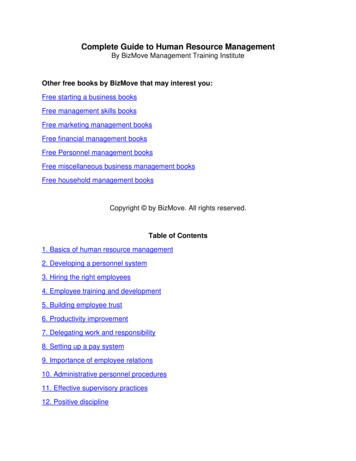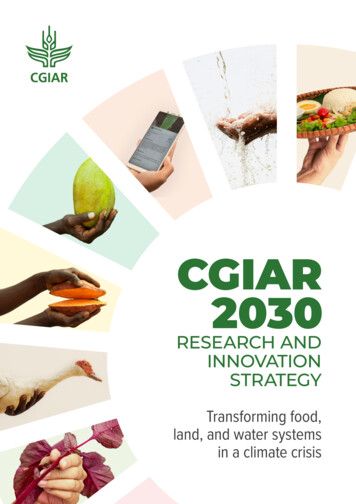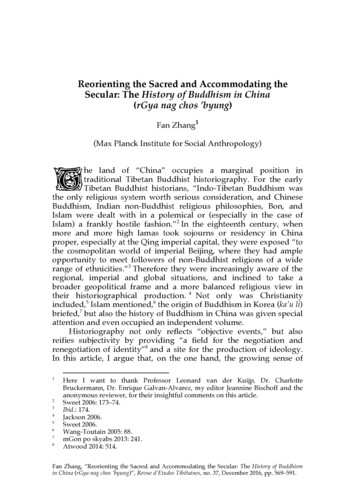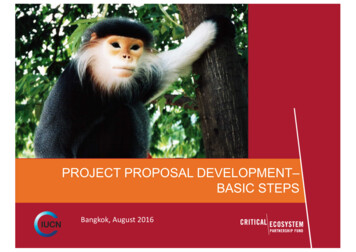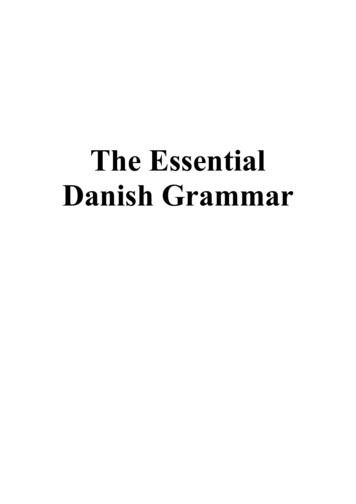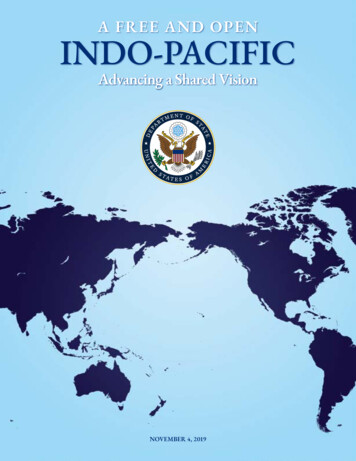
Transcription
A FREE AND OPENINDO-PACIFICAdvancing a Shared VisionNOVEMBER 4, 2019
This page intentionally left blank.
A FREE AND OPEN INDO-PACIFICAdvancing a Shared VisionNOVEMBER 4, 2019
A MESSAGE FROM THE SECRETARYPresident Donald J. Trump has made U.S. engagement in the IndoPacific region a top priority of his Administration. In November 2017in Vietnam, he outlined a vision for a free and open Indo-Pacific inwhich all countries prosper side by side as sovereign, independent states.That vision, shared with billions of people in more than 35 countriesand economies, is based on values that have underpinned peace andprosperity in the Indo-Pacific for generations. Free, fair, and reciprocaltrade, open investment environments, good governance, and freedomof the seas are goals shared by all who wish to prosper in a free andopen future.This report describes how the United States is working with allies andpartners to implement our shared vision: The United States remains deeply engaged in the Indo-Pacific region and committed to itsprosperity. With 1.9 trillion in two-way trade, our futures are inextricably intertwined. U.S.government agencies, businesses, and institutions are spurring private sector investment andgainful employment in infrastructure, energy, and the digital economy, strengthening civil societyand democratic institutions, countering transnational threats, and investing in human capitalacross the Indo-Pacific. The United States, our allies, and our partners are at the forefront of preserving the free andopen regional order. All nations have a shared responsibility to uphold the rules and values thatunderpin a free and open Indo-Pacific. We are increasing the tempo and scope of our work withallies, partners, and regional institutions such as the Association of Southeast Asian Nations(ASEAN), the Mekong states, the Pacific Island countries, and our strategic partner India to addressshared challenges and advance a shared vision. The United States’ Indo-Pacific strategy is driving a tangible increase in resources devoted to theIndo-Pacific region. Since the start of the Trump Administration, the Department of State and theU.S. Agency for International Development (USAID) have provided the region with over 4.5 billionin foreign assistance. This has been augmented by hundreds of billions more in developmentfinancing, investment by U.S. firms, and other sources. We are investing new resources, launchingnew programs, and building new partnerships to ensure a safe, prosperous, and dynamic futurefor the region.I am pleased to share this implementation update on our Indo-Pacific strategy, and to note that our workhas just begun. As President Trump said in November 2017: “We have been friends, partners, and allies inthe Indo-Pacific for a long, long time, and we will be friends, partners, and allies for a long time to come.”Michael R. PompeoSecretary of State4
A FREE AND OPEN INDO-PACIFIC: ADVANCING A SHARED VISIONA Shared VisionU.S. Secretary of State Michael R. Pompeo reaffirmed U.S. dedication to ASEAN during the ASEAN Regional Forum Ministerial in Bangkok,Thailand, on August 2, 2019. (Credit: U.S. Department of State)The United States is and always will be an IndoPacific nation. From our first trading ships thatdeparted for Canton just after the AmericanRevolution to our first consular presence in Kolkata in1794, U.S. engagement in the Indo-Pacific is a story oftrade, exchange, shared sacrifice, and mutual benefit.In recent decades, the Indo-Pacific has undergone aremarkable transformation. As hundreds of millions ofpeople climbed out of poverty, the region has becomehome to world-class companies and an importantengine of global economic growth. This transformationwas possible because a free and open regional orderensured stability and a level playing field on whichcountries could grow and prosper as sovereign,independent states.Today, Indo-Pacific nations face unprecedentedchallenges to their sovereignty, prosperity, andpeace. The U.S. National Security Strategy, releasedin December 2017, recognizes that the mostconsequential challenge to U.S. and partner interests isthe growing competition between free and repressivevisions of the future international order. Authoritarianrevisionist powers seek to advance their parochialinterests at others’ expense.[T]his entire region has emerged — and it isstill emerging — as a beautiful constellationof nations, each its own bright star, satellitesto none — and each one, a people, a culture, away of life, and a home.President Donald TrumpNovember 10, 2017We are committed to upholding a free and open IndoPacific in which all nations, large and small, are securein their sovereignty and able to pursue economicgrowth consistent with international law and principlesof fair competition. We will compete vigorously againstattempts to limit the autonomy and freedom of choiceof Indo-Pacific nations.Competition, however, is not conflict. Rather, it canprevent conflict and elevate the performance of all.The United States and our partners believe that thebest way to prevent conflict is to reinforce the valuesthat supported the Indo-Pacific region’s remarkableprogress.5
A FREE AND OPEN INDO-PACIFIC: ADVANCING A SHARED VISIONThe U.S. vision for the Indo-Pacific excludes no nation.We do not ask countries to choose between onepartner or another. Instead, we ask that they upholdthe core principles of the regional order at a time whenthese principles are under renewed threat.Crowds await President Donald J. Trump, following his meetingsin Hanoi with Nguyen Xuan Phuc, Prime Minister of the SocialistRepublic of Vietnam, an important Indo-Pacific partner. February27, 2019. (Credit: White House)We have a fundamental interest in ensuring thatthe future of the Indo-Pacific is one of freedom andopenness rather than coercion and corruption. TheUnited States is the largest source of foreign directinvestment (FDI) in the Indo-Pacific. In 2018, weconducted over 1.9 trillion in two-way trade with theregion, supporting more than 3 million jobs in theUnited States and 5.1 million jobs in the Indo-Pacific.All five of our non-NATO bilateral defense alliances arein the Indo-Pacific. We are also the largest donor offoreign assistance in the region, contributing 2 trillionin constant dollars since the end of World War II.Under President Trump’s leadership, the United Statesis implementing a whole-of-government strategy i tochampion the values that have served the Indo-Pacificso well: (1) respect for sovereignty and independenceof all nations; (2) peaceful resolution of disputes;(3) free, fair, and reciprocal trade based on openinvestment, transparent agreements, and connectivity;and (4) adherence to international law, includingfreedom of navigation and overflight.6The United States is strengthening and deepeningpartnerships with countries that share our values. Ouralliances with Australia, Japan, the Republic of Korea,the Philippines, and Thailand have helped sustainpeace and security for generations. ASEAN sits at thegeographical center of the Indo-Pacific and is centralto our vision. Our strategic partnership with India, afellow democracy of 1.3 billion people that shares ourvision for the Indo-Pacific, is reaching new heights.We are joining with the Mekong states, Pacific Islandcountries, South Asian nations, Taiwan, and manyothers to face emerging challenges. In September2019, the first ministerial-level meeting of the UnitedStates, Australia, India, and Japan at the QuadrilateralConsultations marked a new milestone for ourdiplomatic engagement in the region.What I call the “Free and Open Indo-PacificStrategy” derives from our desire to preservethe blessings of open seas, together with thesevery countries, as well as the United States,Australia, India, and others, and indeed, allcountries and peoples who share the sameintent.Prime Minister of Japan Shinzo AbeSeptember 25, 2018This report describes our engagement in the IndoPacific and our commitment to its future prosperity.It highlights tangible resources directed to the regionwith support from the United States Congress, andit notes specific steps we have taken alongside alliesand partners to realize our vision since the start of theTrump Administration.
A FREE AND OPEN INDO-PACIFIC: ADVANCING A SHARED VISIONEngaging Partners and Regional InstitutionsPresident Trump and Japan’s Prime Minister Shinzo Abe leave the Akasaka Palace on May 27, 2019, following their afternoon of meetingson Indo-Pacific cooperation and the enduring U.S.-Japan alliance. (Credit: White House)Since the end of World War II, the network of U.S.alliances and partnerships has been at the coreof a stable and peaceful Indo-Pacific. No countrycan shape the future of the region in isolation, andno vision for the region is complete without a robustnetwork of sovereign countries cooperating to securetheir collective interests. Under the Indo-Pacific strategy,the United States has increased its tempo and level ofcooperation with allies and partners in the region.MULTILATERAL ENGAGEMENTA strong, rules-based architecture anchors the U.S. visionfor the Indo-Pacific region. Representing ten countries, 650million people, and a combined GDP of almost 3 trillion,ASEAN is central to this architecture.ii ASEAN is mosteffective when it speaks with one voice about pressingpolitical and security issues, and it took an important stepin this regard with the June 2019 release of its “Outlookon the Indo-Pacific.” We see a clear convergence betweenthe principles enshrined in ASEAN’s Indo-Pacific Outlook—inclusivity, openness, good governance, and respect forinternational law—and the vision of the United Statesfor a free and open Indo-Pacific, as well as the regionalapproaches of our allies, partners, and friends.The United States supports ASEAN’s efforts to ensure thatall Indo-Pacific countries, regardless of their size, haveequal stake in determining the future of the region. U.S.technical assistance strengthens capacity in the energysector; promotes shared approaches to cybersecurityand digital trade; creates opportunities for small andmedium-sized enterprises; and encourages women andyouth innovators and entrepreneurs. U.S. programs alsoFACTASEAN is the top destination for U.S.investment in the Indo-Pacific. In 2018,cumulative U.S. investment in ASEAN was 271billion, more than U.S. FDI in China and Japancombined.7
A FREE AND OPEN INDO-PACIFIC: ADVANCING A SHARED VISIONand security discussions, “minilateral” engagements offernimble ways to coordinate with like-minded partners.Through the Trilateral Strategic Dialogue, the UnitedStates has significantly deepened our engagement withJapan and Australia on many issues, including sustainableinfrastructure development, maritime security, andcounterterrorism. Leaders from the United States, India,and Japan met in November 2018 and June 2019 topromote shared fundamental values such as freedom,democracy, and the rule of law, and to exchange views onpressing security and economic issues. All four countrieselevated their Quadrilateral Consultation to the ministeriallevel in September 2019 (see box, “Growing Partnershipwith India”).Secretary Pompeo hosted a Quadrilateral Consultation withAustralian Foreign Minister Marise Payne, Indian External AffairsMinister Subrahmanyam Jaishankar, and Japanese ForeignMinister Toshimitsu Motegi in New York. September 26, 2019.(Credit: U.S. Department of State)support the ASEAN Economic Community by reducingthe cost of doing business and streamlining trade, while anew partnership between U.S. and ASEAN cities will helprealize smart improvements in transportation and watersecurity.In 2019, we commemorated the 10th anniversary of theLower Mekong Initiative (LMI), a partnership to advanceeconomic growth and narrow the development gap inthe region. LMI builds the capacity of partner countriesin areas such as energy and water security, sustainableinfrastructure, and regional institutions. We continue tosupport the Friends of the Lower Mekong, an importantdonor coordination mechanism.The United States works within the Asia-Pacific EconomicCooperation (APEC) to facilitate digital trade, improvethe ease of doing business, open services markets,and increase women’s economic participation. In 2018,we launched the U.S.-Support for Economic Growth inAsia (US-SEGA) technical assistance program to helppartners adopt high-standard, comprehensive trade andinvestment policies in areas like regulatory requirements,women in science and technology, digital economy,and cyber security. We support the Indian Ocean RimAssociation (IORA) and its focus on maritime economy,women’s economic empowerment, and environmentaland maritime security issues.While ASEAN serves as the backbone of regional political8BILATERAL PARTNERSHIPSThe U.S. vision and approach in the Indo-Pacific regionaligns closely with Japan’s Free and Open Indo-Pacificconcept, India’s Act East Policy, Australia’s Indo-Pacificconcept, the Republic of Korea’s New Southern Policy, andTaiwan’s New Southbound Policy.We are working with Japan to improve energy andinfrastructure under the Japan-U.S. Strategic EnergyPartnership (JUSEP) and Japan-U.S. Strategic DigitalEconomy Partnership (JUSDEP) from the Indo-Pacific tothe east coast of Africa. Our commitment of 29 millionfor energy development in the Mekong region in supportof Asia EDGE (Enhancing Development and Growththrough Energy) will further strengthen this partnership,as will the alignment of U.S. investment with the Japanesegovernment’s target of 10 billion in public and privateinvestment and capacity building.We are working with the Republic of Korea to expanddevelopment collaboration across the Indo-Pacific regionthrough a memorandum of understanding signedSeptember 30 between USAID and the Korea InternationalCooperation Agency (KOICA). A joint statement releasedwith the Republic of Korea in November will build ongovernance and law enforcement programming, increasewater security cooperation in the Mekong region, anddeepen the links across our infrastructure finance andcybersecurity agencies to jointly invest in human capitalacross the region.We are also strengthening and deepening our relationshipwith Taiwan. We have repeatedly expressed ourconcern over Beijing’s actions to bully Taiwan throughmilitary maneuvers, economic pressure, constraints onits international space, and poaching of its diplomaticpartners. These actions undermine the cross-Strait
A FREE AND OPEN INDO-PACIFIC: ADVANCING A SHARED VISIONIndia plays a critical role in the future of the Indo-Pacific region. President Trump and Prime Minister Narendra Modi of India wave tocrowds in Houston, Texas during the Howdy Modi rally, an event that included participation by a bipartisan group of 21 members of theUnited States Congress. September 22, 2019. (Credit: White House)GROWING PARTNERSHIP WITH INDIAA strong U.S.-India partnership is vital to the U.S. Indo-Pacific vision. The inaugural 2 2 Dialogue in 2018 significantlyenhanced our defense and economic cooperation. As a Major Defense Partner, India has purchased more than 16 billion in U.S. defense platforms, with billions more in the pipeline. We signed a bilateral CommunicationsCompatibility and Security Agreement to facilitate defense cooperation in 2018, and plan to hold the first ever triservice bilateral exercise, Tiger Triumph, in November 2019.The United States and India are working together to address regional and global development challenges. The U.S.Australia-India-Japan Quadrilateral Consultations were elevated to the ministerial level in September, a historicfirst for our countries. The ministers affirmed their commitment to cooperation on maritime security, qualityinfrastructure, and regional connectivity, and discussed priorities in counter-terrorism and cyber security. Our armiesare jointly training African peacekeepers and USAID is working with India in third countries to promote child andmaternal health development.India is also a growing energy partner, with purchases of U.S. mineral fuel products jumping 119 percent in 2018 aloneto 6.2 billion. Under the U.S.-India Strategic Energy Partnership, we pursue energy cooperation in power, renewable,efficiency, and oil/gas segments. Space cooperation is another exciting area of opportunity, including a 1.5 billionproject to co-develop an Earth observation satellite called NISAR.9
A FREE AND OPEN INDO-PACIFIC: ADVANCING A SHARED VISIONThe Indo-Pacific region should be seen as aregion of dialogue and cooperation insteadof rivalry, and it should be seen as a region ofdevelopment and prosperity for everyone.Prime Minister of ThailandPrayut Chan-o-chaJune 24, 2019the world’s newest democracies. In Malaysia, the UnitedStates has worked locally to support the government’sreform efforts, including with a two-year programlaunched this year for transparency and accountabilityreforms.President Donald J. Trump stands with Australian Prime MinisterScott Morrison during a review of an honor guard parade at theState Visit arrival September 20, 2019, on the South Lawn of theWhite House. (Credit: White House)status quo that has benefitted both sides of the Strait fordecades.Consistent with the Taiwan Relations Act, the United Statessupports an effective deterrence capability for Taiwan. In2019, the Trump Administration approved and notifiedCongress of potential sales of critical defense equipmenttotaling more than 10 billion Through the AmericanInstitute in Taiwan, we worked together to convenehundreds of Indo-Pacific policymakers and experts onissues including public health, women’s empowerment,media disinformation, and the digital economy. We alsoco-hosted the first-ever Pacific Islands Dialogue in October2019 to explore areas of cooperation among like-mindedpartners in the Pacific Islands.As a major exporter, trader, and investor in SoutheastAsia, the United States is committed to engagementwith ASEAN member states. ASEAN collectively remainsthe United States’ fourth largest export market, whileThailand and Singapore are two of the six fastest growingsources of foreign direct investment in the UnitedStates. In maritime Southeast Asia, U.S. companies havebeen selected to participate in the “Build, Build, Build”infrastructure initiative in the Philippines as we deepenour security partnership. The opening of a new U.S.Embassy in Jakarta in early 2019 highlighted our strategicpartnership with the world’s third largest democracy andlargest Muslim-majority nation, and we remain committedto the sustainable development of Timor-Leste, one of10In mainland Southeast Asia, we supported Thailand’schairmanship of ASEAN and continue to deepen ourpartnership with Vietnam, who will chair ASEAN in2020. The Mekong region of Cambodia, Laos, Burma,Thailand, and Vietnam is strategically important to theUnited States. This region is facing new challenges thatput autonomy and economic independence at risk,including debt dependency, a spree of dam-building thatconcentrates control over downstream flows, plans toblast and dredge riverbeds, extraterritorial river patrols,increasing organized crime and trafficking, and a push bysome to mold new rules to govern the river in ways thatundermine existing institutions.Over the last 10 years, U.S. government agencies haveprovided over 3.8 billion in assistance to the countriesof the Mekong. This has helped strengthen local humancapital to better address transboundary challengeson water security, smart hydropower, energy andinfrastructure planning, and education. We are alsostrong supporters of the Ayeyawady-Chao PhrayaMekong Economic Cooperation Strategy (ACMECS),an inclusive cooperation framework to support thedevelopment of this important region.Our engagement with Pacific Island nations rose tounprecedented levels with President Trump’s historicOval Office meeting with the three Presidents of theFreely Associated States on May 21, 2019; the Secretaryof the Interior’s attendance at the annual Pacific IslandsForum Partners Dialogue in 2018 and 2019; Secretaryof Veterans Affairs Robert Wilkie’s attendance at theinauguration of Micronesian President Panuelo inJuly 2019; and Secretary Pompeo’s historic visit to theFederated States of Micronesia in August 2019.
A FREE AND OPEN INDO-PACIFIC: ADVANCING A SHARED VISIONSecretary Pompeo met with Foreign Minister Pradeep Gyawali of Nepal, highlighting the enduring strength of the U.S.-Nepal partnership andthe close people-to-people ties that form the foundation of the relationship. December 18, 2018. (Credit: U.S. Department of State)In September 2019, the United States announced a new 100 million “Pacific Pledge.” This assistance is in additionto the approximately 350 million annually that U.S.agencies invest in projects, assistance, and operationsto build a more prosperous future for the people ofthe region. As part of the Pacific Pledge, USAID plans toprovide more than 62 million in new programs over thenext year, more than doubling development assistanceover prior years. This year, the United States also madean initial grant to the Asian Development Bank’s (ADB’s)Pacific Region Infrastructure Facility (PRIF) to supportinfrastructure planning in the Pacific Islands. In addition,USAID will expand its staff presence in Fiji, Papua NewGuinea (PNG), the Federated States of Micronesia, theRepublic of the Marshall Islands, and Palau.The United States is broadening our close cooperationwith Australia and New Zealand in the Pacific and beyondin such areas as infrastructure development in the IndoPacific, joint operations countering illegal, unreported,and unregulated fishing, science and space collaboration,and securing our critical mineral supply chain. Thesepartnerships magnify our impact on improving access forThe key to progress was individual, likeminded sovereign nations acting togetherwith enlightened self-interest it was theprincipled actions of nation states, mostoften led by the United States, bindingtogether the liberal democracies of thewestern world.Prime Minister Scott MorrisonSeptember 23, 2019Pacific Island nations to high-quality, resilient developmentof their economic and natural resources. On September27, the United States announced that we are contributing 23 million to the Papua New Guinea ElectrificationPartnership (PEP) with Australia, Japan, and New Zealand,following through on the commitment made by VicePresident Pence at APEC in 2018. The PEP seeks to connect70 percent of PNG’s population to electricity by 2030, upfrom 13 percent today.11
A FREE AND OPEN INDO-PACIFIC: ADVANCING A SHARED VISIONDeputy Secretary of State John J. Sullivan, in an historic first, meets with Foreign Minister Tandi Dorji at the Ministry of Foreign Affairsin Bhutan. August 12, 2019. (Credit: U.S. Department of State)The United States is also increasing bilateralengagement with South Asian partners. We are helpingSri Lanka, Bangladesh, and Maldives equip and traintheir navies and coast guards to safeguard strategicsea lines of communication, combat human trafficking,prevent illegal fishing, disrupt drug smuggling, andrespond to natural disasters. Piracy and thefts havedropped by 70 percent in the Bay of Bengal thanks tothe Bangladesh Navy and Coast Guard utilizing boatsprocured under various U.S. programs as well as U.S.training.We have helped United Nations (UN) peacekeepingcontributing states like Bangladesh and Nepalbecome more effective by providing equipment, suchas the Unmanned Aircraft System we transferredto Bangladesh, and by providing training for thesepartners’ senior military officers at Americanprofessional military education schools.12The United States is enhancing the counterterrorismcapacity of our South Asian partners through hands-oninvestigative assistance, such as the deployment of FBIinvestigators to Sri Lanka after the ISIS-inspired terroristattacks on Easter Sunday, as well as helping to preventattacks through enhanced border control processes andtechnology in countries like Bangladesh and Maldives.Following the Maldives’ election last year that brought topower a reform-oriented leader committed to rebuildingthe country’s democratic institutions, we mobilized 23million in foreign assistance to encourage the country’santi-corruption, rule of law, and counterterrorismagenda.These and other engagements highlight the importancethe United States places on South Asian partners’political autonomy and their role in an inclusive IndoPacific vision.
A FREE AND OPEN INDO-PACIFIC: ADVANCING A SHARED VISIONEnhancing Economic ProsperityMarket-based economic systems, private sectorfinance, and open investment environments havedriven the Indo-Pacific region’s prosperity. In thedeveloping world, the private sector supplies nine of tenjobs, and foreign direct investment exceeds developmentassistance by a factor of five to one.iii State-directedfinancing, by contrast, is more limited and often comeswith strings attached.The United States believes that the role of government isto enable free enterprise while protecting individual rightsand empowering people. We respect the sovereigntyof every nation, and our economic engagement seeksto equip states to resist coercive economic practices,unsustainable debt burdens, and other dangers. We dothis by improving market access and competitiveness,facilitating business-to-business ties, and promoting free,fair, and reciprocal trade.At the inaugural Indo-Pacific Business Forum in July 2018,Secretary of State Mike Pompeo, Secretary of CommerceWilbur Ross, Secretary of Energy Rick Perry, U.S. Agencyfor International Development Administrator Mark Green,and other senior U.S. officials launched new initiativesto catalyze private sector investment in Indo-Pacificinfrastructure, energy markets, and the digital economy.To date, support has included 2.9 billion through theDepartment of State and USAID for the economic pillar ofthe Indo-Pacific strategy since the beginning of the TrumpAdministration, and hundreds of millions more throughother agencies, including the U.S. Millennium ChallengeCorporation (MCC) and the Overseas Private InvestmentCorporation (OPIC).The U.S. government is deploying new and innovativemechanisms to improve market access and level theplaying field for U.S. businesses. The U.S. InternationalDevelopment Finance Corporation (DFC), created by theBetter Utilization of Investments Leading to Development(BUILD) Act in 2018, will be at the forefront of this effortwith 60 billion in development financing to attract moreprivate sector investment into emerging markets (seepage 16).USAID is another major contributor to businessenvironment development, with longstanding programsto improve regulatory and economic practices. USAID isexpanding programs focused on Indo-Pacific trade andcompetitiveness to help reduce barriers to market entry,strengthen regulatory capacity, improve private sectorcompetitiveness, and increase trade.In 2019 alone, USAID launched new trade andcompetitiveness activities in countries includingBangladesh, Burma, Laos, Mongolia, and the Philippines.These programs build off of USAID’s recent successes. Forexample, in September 2019, USAID supported PuertoPrincesa City in the Philippines in attracting 540 millionworth of commercial investment pledges in tourism,food, agriculture, fisheries, and education. In TimorLeste, USAID helped the customs authority cut clearancetimes in half at a seaport in Dili, and move the customsauthority toward compliance with international standardsrequired for accession to organizations such as the WorldCustoms Organization, the World Trade Organization,and ASEAN. In Vietnam, USAID’s new trade facilitationprogram will build the capacity of Vietnam’s customsdepartment to comply with global trade norms, reducingthe time and cost of trade.FACTAfter USAID supported Vietnam’s reformof over 180 commercial laws and regulations,Vietnam’s competitiveness ranking in the WorldBank’s “Doing Business” report rose from 82ndin 2017 to 68th in 2018.MCC, which delivers results-oriented developmentassistance based on core principles of good governance,country ownership, and transparency, has granted some 2.3 billion to Indo-Pacific nations since 2004. MCC signeda 350 million compact with Mongolia in July 2018 andfinalized a 480 million compact with Sri Lanka in April2019 that is pending Sri Lankan cabinet approval. MCCis currently developing compacts with Timor-Leste andIndonesia and a threshold program with the SolomonIslands.The U.S. Department of the Treasury has establishedframeworks with Ministries of Finance in Japan, SouthKorea, and Singapore to strengthen capital markets.13
A FREE AND OPEN INDO-PACIFIC: ADVANCING A SHARED VISIONPresident Trump participates in a trade agreement signingceremony with Japan Prime Minister Shinzo Abe. Private-sectorled growth is key to the region’s future. September 25, 2019.(Credit: White House)These entities will also work to address legal, regulatory,and institutional barriers to private investment incountries across the Indo-Pacific region.The U.S. Department of Commerce is at the forefrontof U.S. efforts to build business ties in the region.The Department’s Access Asia outreach program, whichconnects American firms with commercial opportunitiesin Indo-Pacific markets, has engaged more than 1,000 U.S.companies since 2018. The Department’s largest annualdomestic conference, Discover Global Markets, furtherstrengthened Indo-Pacific business connections. TradeWinds, the largest U.S. trade mission of 2019, brought 100U.S. companies to India and Bangladesh. Trade Winds willreturn to the Indo-Pacific in 2020, stopping in Hong Kong,South Korea, Japan, Vietnam, and Thailand.The United States Congress confirmed a board for theExport-Import Bank of the United States (EXIM) in May2019, restoring the full range of EXIM programs to addressthe nearly 40 bil
7 A FREE AND OPEN INDO-PACIFIC ADVANCING A SHARED VISION Engaging Partners and Regional Institutions President Trump and Japan’s Prime Minister Shinzo Abe leave the Akasaka Palace on May 27, 2019, following their afternoon of m eetings on Indo-Pacific

